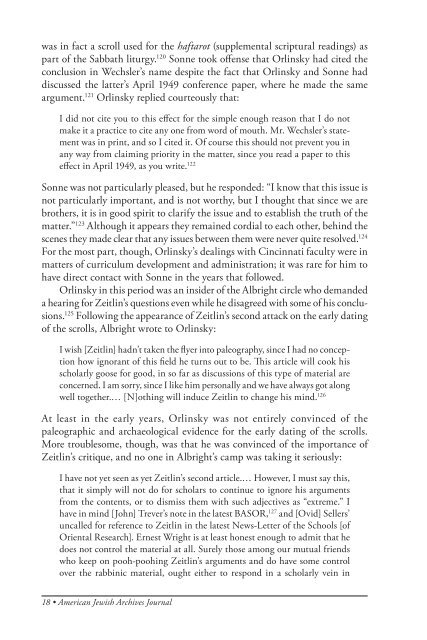The American Jewish Archives Journal, Volume LXI 2009, Number 1
The American Jewish Archives Journal, Volume LXI 2009, Number 1
The American Jewish Archives Journal, Volume LXI 2009, Number 1
You also want an ePaper? Increase the reach of your titles
YUMPU automatically turns print PDFs into web optimized ePapers that Google loves.
was in fact a scroll used for the haftarot (supplemental scriptural readings) as<br />
part of the Sabbath liturgy. 120 Sonne took offense that Orlinsky had cited the<br />
conclusion in Wechsler’s name despite the fact that Orlinsky and Sonne had<br />
discussed the latter’s April 1949 conference paper, where he made the same<br />
argument. 121 Orlinsky replied courteously that:<br />
I did not cite you to this effect for the simple enough reason that I do not<br />
make it a practice to cite any one from word of mouth. Mr. Wechsler’s statement<br />
was in print, and so I cited it. Of course this should not prevent you in<br />
any way from claiming priority in the matter, since you read a paper to this<br />
effect in April 1949, as you write. 122<br />
Sonne was not particularly pleased, but he responded: “I know that this issue is<br />
not particularly important, and is not worthy, but I thought that since we are<br />
brothers, it is in good spirit to clarify the issue and to establish the truth of the<br />
matter.” 123 Although it appears they remained cordial to each other, behind the<br />
scenes they made clear that any issues between them were never quite resolved. 124<br />
For the most part, though, Orlinsky’s dealings with Cincinnati faculty were in<br />
matters of curriculum development and administration; it was rare for him to<br />
have direct contact with Sonne in the years that followed.<br />
Orlinsky in this period was an insider of the Albright circle who demanded<br />
a hearing for Zeitlin’s questions even while he disagreed with some of his conclusions.<br />
125 Following the appearance of Zeitlin’s second attack on the early dating<br />
of the scrolls, Albright wrote to Orlinsky:<br />
I wish [Zeitlin] hadn’t taken the flyer into paleography, since I had no conception<br />
how ignorant of this field he turns out to be. This article will cook his<br />
scholarly goose for good, in so far as discussions of this type of material are<br />
concerned. I am sorry, since I like him personally and we have always got along<br />
well together.… [N]othing will induce Zeitlin to change his mind. 126<br />
At least in the early years, Orlinsky was not entirely convinced of the<br />
paleographic and archaeological evidence for the early dating of the scrolls.<br />
More troublesome, though, was that he was convinced of the importance of<br />
Zeitlin’s critique, and no one in Albright’s camp was taking it seriously:<br />
I have not yet seen as yet Zeitlin’s second article.… However, I must say this,<br />
that it simply will not do for scholars to continue to ignore his arguments<br />
from the contents, or to dismiss them with such adjectives as “extreme.” I<br />
have in mind [John] Trever’s note in the latest BASOR, 127 and [Ovid] Sellers’<br />
uncalled for reference to Zeitlin in the latest News-Letter of the Schools [of<br />
Oriental Research]. Ernest Wright is at least honest enough to admit that he<br />
does not control the material at all. Surely those among our mutual friends<br />
who keep on pooh-poohing Zeitlin’s arguments and do have some control<br />
over the rabbinic material, ought either to respond in a scholarly vein in<br />
18 • <strong>American</strong> <strong>Jewish</strong> <strong>Archives</strong> <strong>Journal</strong>

















